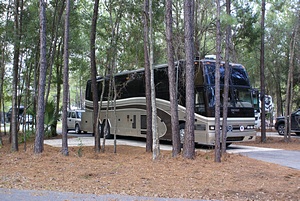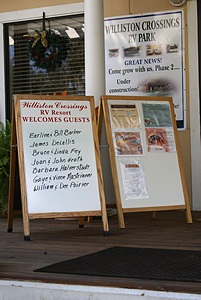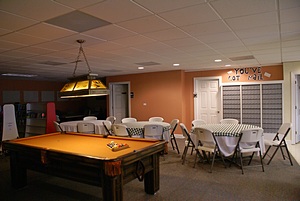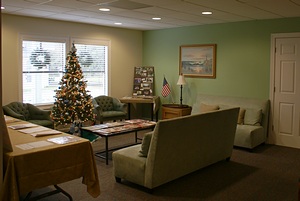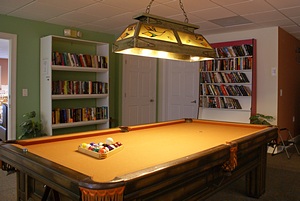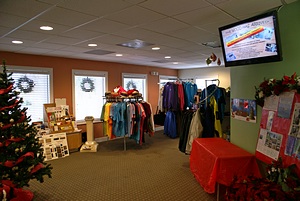I got up at 6 AM, fed the cats, turned on the engine block heater and the Aqua-Hot electric heating element, and then sat on the sofa with the heater pad on my back until 7:20 when I got dressed. Linda was awake at 6 but fell back asleep and did not get up until after 7:30 AM. We had toast and bananas for breakfast but no coffee or tea.
We had 342 miles to travel today to get to John Palmer’s place northeast of Mayo, Florida. He operates Palmer Energy Systems (http://palmerenergysystems.com). We had already driven almost 700 miles, not all of it due south, of course, so we estimated that we were at least 600 miles farther south than our house. It may not seem like that much on a planet with a 24,000 mile circumference but it’s enough to make a big difference in the climate and weather. I was going to check/adjust all of the tires before we left this morning but the temperature was only slightly warmer than when we left home. The TireTraker TPMS seemed to indicate that the tires were OK (although I do not trust the readings I am getting) so I just inspected them visually.
Once again we targeted an 8:30 AM departure time and actually pulled out of our site at 8:35. As soon as we pulled onto I-75 southbound we were in heavier traffic than I expected and it only got worse the farther south we went. It was reasonably smooth sailing all things considered, those things being: construction zones, dense traffic, sunshine (we were driving south, more or less), and drivers who didn’t know how to use an entrance ramp to merge onto a freeway. The last one is one of the banes of my bus driving experience.
We only stopped twice. The first stop was around 11 AM at the rest area near MM179 (south of Atlanta) to use the bathroom and give the cats a chance to do the same. The second stop was at the rest area near MM59 around 12:30 PM. We stopped long enough to have a snack of sliced apples, have something to drink, and use the bathroom. It also gave the cats a chance to eat, drink, and use the litter tray. I called John to get final instructions on how to get into his place. That turned out to be a useful call; he confirmed that we would not have any problem with US-129/FL-51 traffic circle in Live Oak, Florida. He also gave a specific tip to “pull off the road into the ditch (on the right) to swing wide enough to make the turn (to the left) onto his street from the county road.”
Because we were stopping for more than a few minutes I shut off the engine. The Battery Balance light came on as I was pulling into the rest stop. This light does not come on very often and usually only stays on for a few seconds and then goes off and stays off. When I first turned the ignition switch on in Berea it came on and stayed on for several minutes but then turned off and stayed off. It did not come on this morning when I first turned the ignition switch on in Cartersville, so I thought we might be OK (although I did not really believe that). With the engine off (alternator not running), but the ignition switch on, the 24V and 12V gauges indicated less than full charge voltages. I did not recall having ever seen that condition before.
We were back on the road by 1 PM with the OTR A-C turned on. As always the A-C Low Pressure warning light came on occasionally but it always went off after a relatively short time. Of more concern was the Battery Balance light, which went on and off for the next 40 miles. Sometimes it would flicker but other times it would stay on for a long time. Not good.
Caution and warning lights always add an element of stress to driving the bus, but Linda experiences it too from the co-pilot/navigator seat. She knows that it stresses me and she can see the lights from her seat, so she knows what is going on at the same time I do. In spite of the warning light the rest of the trip was smooth and uneventful. We had much less traffic as soon as we exited I-75 onto US-129 in Florida. We encountered a bit more traffic and had a slow roll through Live Oak, Florida. Once we were on FL-51 headed south towards Mayo, Florida we had almost no traffic. We crossed the Suwannee River twice, the second time just north of Mayo, and shortly thereafter made our turn onto CR-354 and headed east parallel to the river.
We found John’s street and followed his advice on how to get the bus in. The problem was that the County Road was not that wide and John’s street was even narrower. It also had signs on posts on each side right at the shoulder of the County Road. That geometry meant that a long vehicle could not cut the corners and had to pass fairly straight between the sign posts. The grassy shoulder was wide enough, before dropping off slightly into a drainage ditch, that I was able to get the passenger side tires well off the road and the driver side tires to the edge of the pavement. It was also firm enough that I was not concerned about the passenger side tires getting stuck in soft soil. I stopped and lifted the tag axles, to shorten the turning radius, and then pulled forward until I was looking down the road out my side window. I then turned the front wheels to the left all the way to the stops and slowly made the turn. I judged it just right, something I have gotten better at doing with experience, and we made it in without difficulty. That was good because we had the car in tow behind the bus and could not back up. If I had not made the turn we would have blocked the County Road for at least 10 minutes while we unhooked the car. We slowly worked our way up to the buildings at the end of the road and I left the bus running while I went to find John.
John was in his trailer but heard me calling and came out. He drove me through the parking approach in his Kubota utility cart and dropped me back at the coach. I got it parked in a spot that had afternoon shade, leveled it, and shut the engine off while Linda opened a couple of windows and a roof vent. John wanted to give us a tour of the property so I did not turn off the chassis batteries or close the air valves the way I normally would on arrival, but took care of that when we got back from our tour.
John is the caretaker for 400 acres of plantation pine woodland with a 25 year lease on 70 of the acres. The owners still live on the property but are in their 80’s and one of their three children has a house on some of the acres. John’s son, Pat, also has a trailer here and works with his dad. There is a third guy here named Terry who works with John and also has a trailer.
Besides taking care of the property John has a solar energy business and a canopy business, all operated out of trailers that can be moved if/when needed. He has been here for six years. In that time he has created over six miles of trails through the woods and along the high south bank of the Suwannee River and cleared small areas for tents and a couple larger areas for RVs. He does not run a campground or charge fees; the space is for friends and customers to use while they are here. It’s a pretty neat place, kind of like a private state park, with access to the Suwannee River.
Back at the coach we talked about a solar installation for the bus and then John gave me a tour of his workshop and inventory trailers. We probably won’t do anything relative to solar while we are here but I wanted to get John’s opinion on some things, which I did. John knows what he knows and doesn’t pull any punches. He has lived an off-grid, solar lifestyle for over a quarter century and he thinks solar systems on bus conversions are a waste of money as buses require substantial AC electrical power from a shoreline or Genset to really function fully and properly. I concede that he is basically correct (unless you spend a lot of time in the southwest) but his utilitarian logic does not place any value on the “I want it because it’s cool” factor.
When I was done talking to John about solar stuff I opened the tray with the battery disconnect switches and the Vanner Equalizers (the coach has two of them operating in parallel) and checked to make sure the circuit breakers had not popped. I had no way of knowing if they were operating correctly but I ruled out their shutting off as the cause of the chassis battery balance situation. There was some corrosion on the terminals but not enough to cause a problem. When I finally started the generator at 4:30 PM the maintenance charger for the upper 12V strand of the 24V chassis battery bank showed 25% SOC. That was definitely not good and suggested that one or both of the upper 12V batteries had failed. They are 5-to-6 years old so that would not come as a surprise.
I texted Chuck, described what I had found, and indicated that I planned to go buy four batteries tomorrow. He asked if I still had my American Independent Trucker Association (AITA) NAPA Discount Card that we got through Prevost Community. I did, and it did not expire until the end of the month, so tomorrow I will see if there is a NAPA store nearby with batteries I need in stock.
I set up the Amped Wireless router, the NAS, and my computer AC power adapter and connected the NAS and computer to the router with network cables. I powered all of them up, turned on the Verizon Mi-Fi, and got the WiFiRanger connected to the Mi-Fi. The Amped Wireless router connected to the WiFiRanger and everything worked as intended. We were online so I checked e-mail.
Linda heated up a can of Amy’s chili for dinner, which we had with Saltine crackers and a little vegan “butter.” I sliced up an apple later for dessert.
I tried calling Butch but did not reach him so I tuned in a TV station and worked on this post. I tried Butch again later and finally got through to him. We had not talked in several weeks so we had a nice chat. Butch thought our batteries should have lasted seven years, given the way I use and maintain them, but conceded that five years is a typical lifespan. He also mentioned that Nick Russell had used the picture I sent of our bus covered in snow in his blog. I have not had a chance to check Nick’s blog in a while so I found the post when I was done talking to Butch.
By now it was 10:30 PM and I needed to get to bed. John was leaving for breakfast at 7:15 AM and I had indicated that I would go with him so I did not want to be up too late and risk oversleeping.
